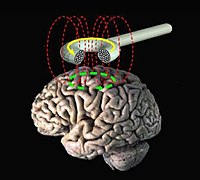
Photo from wikipedia
Autism spectrum disorder (ASD) is a heterogeneous disorder that affects several behavioral domains of neurodevelopment. Transcranial direct current stimulation (tDCS) is a new method that modulates motor and cognitive function… Click to show full abstract
Autism spectrum disorder (ASD) is a heterogeneous disorder that affects several behavioral domains of neurodevelopment. Transcranial direct current stimulation (tDCS) is a new method that modulates motor and cognitive function and may have potential applications in ASD treatment. To identify its potential effects on ASD, differences in electroencephalogram (EEG) microstates were compared between children with typical development (n = 26) and those with ASD (n = 26). Furthermore, children with ASD were divided into a tDCS (experimental) and sham stimulation (control) group, and EEG microstates and Autism Behavior Checklist (ABC) scores before and after tDCS were compared. Microstates A, B, and D differed significantly between children with TD and those with ASD. In the experimental group, the scores of microstates A and C and ABC before tDCS differed from those after tDCS. Conversely, in the control group, neither the EEG microstates nor the ABC scores before the treatment period (sham stimulation) differed from those after the treatment period. This study indicates that tDCS may become a viable treatment for ASD.
Journal Title: Bioengineering
Year Published: 2023
Link to full text (if available)
Share on Social Media: Sign Up to like & get
recommendations!